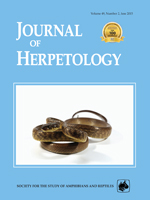Northern range limits for snakes may result from thermal constraints, especially for oviposition and hibernation. We characterized hibernation and oviposition sites for federally threatened Great Basin Gophersnakes (Pituophis catenifer deserticola) near the edge of their northern-range limit in south central British Columbia, Canada. During 2006 and 2007, most Gophersnakes (75.8%) hibernated alone. At our more northern study area, typical hibernation sites were in grassy hillsides, whereas at our southern study areas snakes hibernated in rocky outcrops. All snakes that denned in rock outcrops reused sites over years, but only 28.6% of snakes that hibernated in rodent burrows reused sites. Most female Gophersnakes (94%) laid eggs in sites that were not used by other females, and reuse of sites was rare (12.5%). Almost all of the oviposition sites were in grassy slopes, with any shrubs and trees more than 5 m away; females selected grassy or sage-steppe cover for oviposition. This pattern of mostly individual and single-use hibernation and oviposition sites suggests that hibernation and oviposition sites are readily available as components of the active-season range within the sage-steppe ecozone, although this habitat is rare and severely threatened within Canada. In terms of species conservation, areas of suitable habitat should be protected based on active-season use, rather than by attempting to find hibernation sites supporting large aggregations of snakes. This recommendation is unlike that for Rattlesnakes (Crotalus spp.) and Gartersnakes (Thamnophis spp.), which often congregate at hibernation sites.
How to translate text using browser tools
1 June 2015
Hibernation and Oviposition Sites of Great Basin Gophersnakes (Pituophis catenifer deserticola) near Their Northern Range Limit
Kathleen E. Williams,
Karen E. Hodges,
Christine A. Bishop
ACCESS THE FULL ARTICLE

Journal of Herpetology
Vol. 49 • No. 2
June 2015
Vol. 49 • No. 2
June 2015




